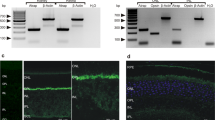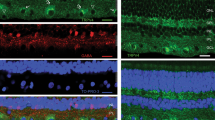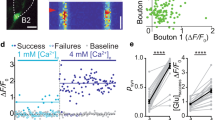Abstract
Feedback inhibition at reciprocal synapses between A17 amacrine cells and rod bipolar cells (RBCs) shapes light-evoked responses in the retina1,2,3. Glutamate-mediated excitation of A17 cells elicits GABA (γ-aminobutyric acid)-mediated inhibitory feedback onto RBCs4,5,6, but the mechanisms that underlie GABA release from the dendrites of A17 cells are unknown. If, as observed at all other synapses studied, voltage-gated calcium channels (VGCCs) couple membrane depolarization to neurotransmitter release7, feedforward excitatory postsynaptic potentials could spread through A17 dendrites to elicit ‘surround’ feedback inhibitory transmission at neighbouring synapses. Here we show, however, that GABA release from A17 cells in the rat retina does not depend on VGCCs or membrane depolarization. Instead, calcium-permeable AMPA (α-amino-3-hydroxy-5-methyl-4-isoxazole propionic acid) receptors (AMPARs), activated by glutamate released from RBCs, provide the calcium influx necessary to trigger GABA release from A17 cells. The AMPAR-mediated calcium signal is amplified by calcium-induced calcium release (CICR) from intracellular calcium stores. These results describe a fast synapse that operates independently of VGCCs and membrane depolarization and reveal a previously unknown form of feedback inhibition within a neural circuit.
This is a preview of subscription content, access via your institution
Access options
Subscribe to this journal
Receive 51 print issues and online access
$199.00 per year
only $3.90 per issue
Buy this article
- Purchase on Springer Link
- Instant access to full article PDF
Prices may be subject to local taxes which are calculated during checkout




Similar content being viewed by others
References
Nakatsuka, K. & Hamasaki, D. I. Destruction of the indoleamine-accumulating amacrine cells alters the ERG of rabbits. Invest. Ophthalmol. Vis. Sci. 26, 1109–1116 (1985)
Euler, T. & Masland, R. H. Light-evoked responses of bipolar cells in a mammalian retina. J. Neurophysiol. 83, 1817–1829 (2000)
Dong, C. J. & Hare, W. A. Temporal modulation of scotopic visual signals by A17 amacrine cells in mammalian retina in vivo. J. Neurophysiol. 89, 2159–2166 (2003)
Hartveit, E. Membrane currents evoked by ionotropic glutamate receptor agonists in rod bipolar cells in the rat retinal slice preparation. J. Neurophysiol. 76, 401–422 (1996)
Hartveit, E. Reciprocal synaptic interactions between rod bipolar cells and amacrine cells in the rat retina. J. Neurophysiol. 81, 2923–2936 (1999)
Singer, J. H. & Diamond, J. S. Sustained Ca2+ entry elicits transient postsynaptic currents at a retinal ribbon synapse. J. Neurosci. 23, 10923–10933 (2003)
Katz, B. & Miledi, R. The timing of calcium action during neuromuscular transmission. J. Physiol. (Lond.) 189, 535–544 (1967)
Kolb, H. & Nelson, R. Amacrine cells of the cat retina. Vision Res. 21, 1625–1633 (1981)
Sterling, P. & Lampson, L. A. Molecular specificity of defined types of amacrine synapse in cat retina. J. Neurosci. 6, 1314–1324 (1986)
Nelson, R. & Kolb, H. A17: a broad-field amacrine cell in the rod system of the cat retina. J. Neurophysiol. 54, 592–614 (1985)
Sandell, J. H. & Masland, R. H. A system of indoleamine-accumulating neurons in the rabbit retina. J. Neurosci. 6, 3331–3347 (1986)
Vaney, D. I. Morphological identification of serotonin-accumulating neurons in the living retina. Science 233, 444–446 (1986)
Singer, J. H., Lassova, L., Vardi, N. & Diamond, J. S. Coordinated multivesicular release at a mammalian ribbon synapse. Nature Neurosci. 7, 826–833 (2004)
Vigh, J. & von Gersdorff, H. Prolonged reciprocal signalling via NMDA and GABA receptors at a retinal ribbon synapse. J. Neurosci. 25, 11412–11423 (2005)
Bloomfield, S. A. & Xin, D. Surround inhibition of mammalian AII amacrine cells is generated in the proximal retina. J. Physiol. (Lond.) 523, 771–783 (2000)
Shields, C. R. & Lukasiewicz, P. D. Spike-dependent GABA inputs to bipolar cell axon terminals contribute to lateral inhibition of retinal ganglion cells. J. Neurophysiol. 89, 2449–2458 (2003)
Menger, N. & Wassle, H. Morphological and physiological properties of the A17 amacrine cell of the rat retina. Vis. Neurosci. 17, 769–780 (2000)
Baumgarten, H. G. et al. Mode and mechanism of action of neurotoxic indoleamines: a review and a progress report. Ann. NY Acad. Sci. 305, 3–24 (1978)
Schoppa, N. E. & Urban, N. N. Dendritic processing within olfactory bulb circuits. Trends Neurosci. 26, 501–506 (2003)
Washburn, M. S. & Dingledine, R. Block of alpha-amino-3-hydroxy-5-methyl-4-isoxazolepropionic acid (AMPA) receptors by polyamines and polyamine toxins. J. Pharmacol. Exp. Ther. 278, 669–678 (1996)
Nawy, S. Desensitization of the mGluR6 transduction current in tiger salamander On bipolar cells. J. Physiol. (Lond.) 558, 137–146 (2004)
Hess, P., Lansman, J. B. & Tsien, R. W. Different modes of Ca channel gating behaviour favoured by dihydropyridine Ca agonists and antagonists. Nature 311, 538–544 (1984)
Sidach, S. S. & Mintz, I. M. Kurtoxin, a gating modifier of neuronal high- and low-threshold ca channels. J. Neurosci. 22, 2023–2034 (2002)
Brandstatter, J. H., Koulen, P. & Wassle, H. Selective synaptic distribution of kainate receptor subunits in the two plexiform layers of the rat retina. J. Neurosci. 17, 9298–9307 (1997)
Zhang, J., Li, W., Trexler, E. B. & Massey, S. C. Confocal analysis of reciprocal feedback at rod bipolar terminals in the rabbit retina. J. Neurosci. 22, 10871–10882 (2002)
Drose, S. & Altendorf, K. Bafilomycins and concanamycins as inhibitors of V-ATPases and P-ATPases. J. Exp. Biol. 200, 1–8 (1997)
Verkhratsky, A. & Petersen, O. H. The endoplasmic reticulum as an integrating signalling organelle: from neuronal signalling to neuronal death. Eur. J. Pharmacol. 447, 141–154 (2002)
Warrier, A., Borges, S., Dalcino, D., Walters, C. & Wilson, M. Calcium from internal stores triggers GABA release from retinal amacrine cells. J. Neurophysiol. 94, 4196–4208 (2005)
Sjostrom, P. J. & Nelson, S. B. Spike timing, calcium signals and synaptic plasticity. Curr. Opin. Neurobiol. 12, 305–314 (2002)
Singer, J. H. & Diamond, J. S. Vesicle depletion and synaptic depression at a mammalian ribbon synapse. J. Neurophysiol. 95, 3191–3198 (2006)
Acknowledgements
We thank K. Swartz for his gift of kurtoxin, J. Isaac for his gift of GYKI 53655, and J. Isaac, D. Copenhagen, C. Jahr and members of the Diamond laboratory for comments on the manuscript. This research was supported by the NINDS Intramural Research Program and a K22 award to J.H.S. A.E.C. is a doctoral student in a graduate program partnership between NIH and the University of Valparaíso, Chile. Author Contributions A.E.C. and J.H.S. collected and analysed data and helped to design experiments; J.S.D. directed the study, helped to design experiments and wrote the manuscript.
Author information
Authors and Affiliations
Corresponding author
Ethics declarations
Competing interests
Reprints and permissions information is available at www.nature.com/reprints. The authors declare no competing financial interests.
Supplementary information
Supplementary Figures
Supplementary Figures 1–4 illustrate experiments that demonstrate the specificity of DHT (Supplementary Fig. 1), the spatial resolution of glutamate puffs (Supplementary Fig. 2), the Cd-sensitivity of glycinergic gIPSCs (Supplementary Fig. 3), and a comparison of different approaches to measure vIPSC amplitude (Supplementary Fig. 4). (PDF 1528 kb)
Supplementary Methods
Complete description of experimental and analytical methods. (PDF 72 kb)
Rights and permissions
About this article
Cite this article
Chávez, A., Singer, J. & Diamond, J. Fast neurotransmitter release triggered by Ca influx through AMPA-type glutamate receptors. Nature 443, 705–708 (2006). https://doi.org/10.1038/nature05123
Received:
Accepted:
Published:
Issue Date:
DOI: https://doi.org/10.1038/nature05123
This article is cited by
-
Affecting AMPA Receptor Biophysical Gating Properties with Negative Allosteric Modulators
Molecular Neurobiology (2022)
-
Electrical coupling between A17 cells enhances reciprocal inhibitory feedback to rod bipolar cells
Scientific Reports (2018)
-
Channel properties reveal differential expression of TARPed and TARPless AMPARs in stargazer neurons
Nature Neuroscience (2012)
-
Intracellular Ca2+ release through ryanodine receptors contributes to AMPA receptor-mediated mitochondrial dysfunction and ER stress in oligodendrocytes
Cell Death & Disease (2010)
-
BK channels modulate pre- and postsynaptic signaling at reciprocal synapses in retina
Nature Neuroscience (2009)
Comments
By submitting a comment you agree to abide by our Terms and Community Guidelines. If you find something abusive or that does not comply with our terms or guidelines please flag it as inappropriate.



